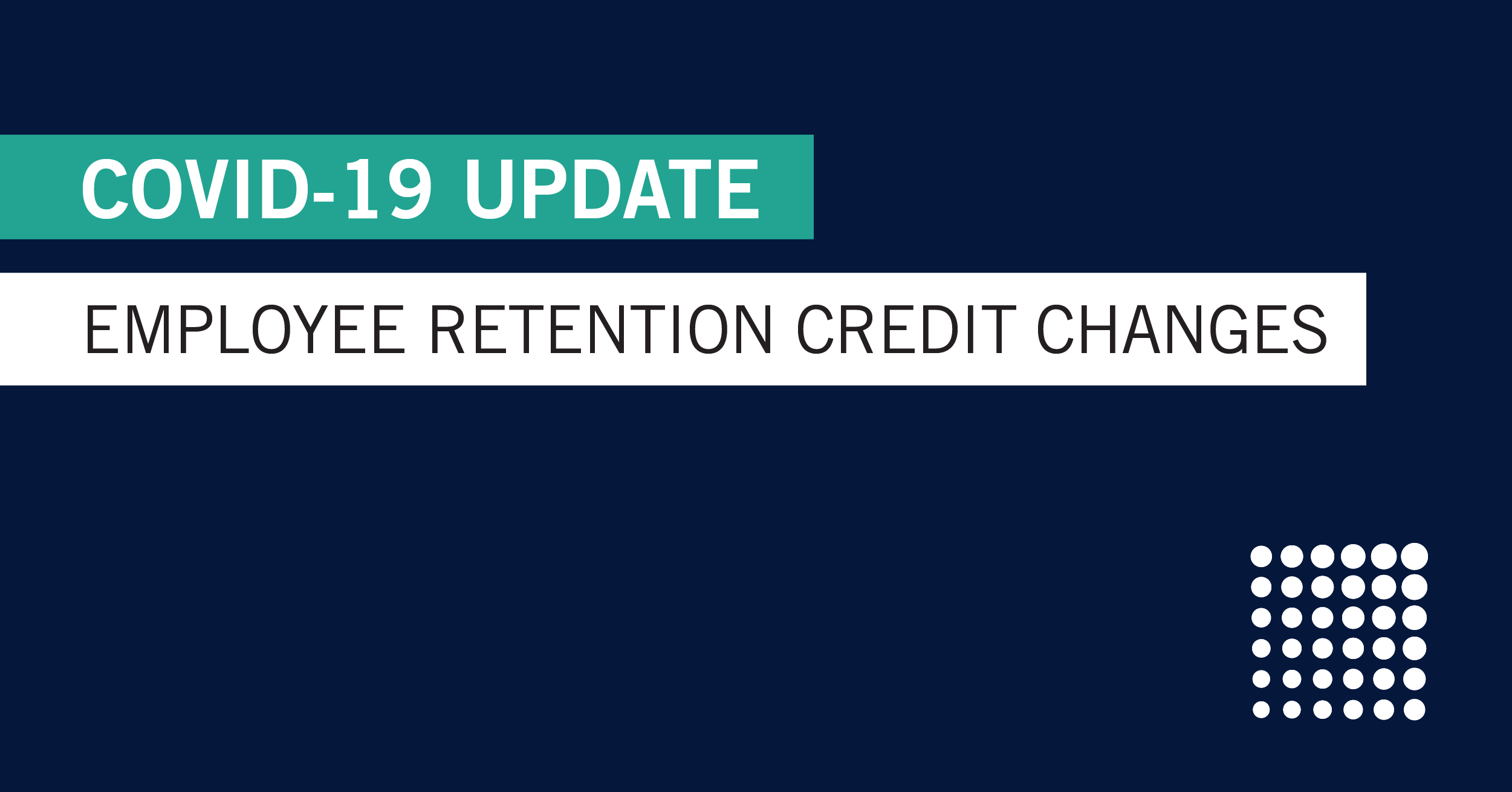Free tool to help you apply new guidance to your tax return
There has been tremendous discussion over the past two months on the availability of the Employee Retention Credit (ERC) based on changes made by the Consolidated Appropriations Act (CAA). CWA has spent a substantial amount of time researching to ensure all qualifying CWA clients can take full advantage of the ERC and still receive 100% Paycheck Protection Program (PPP1) forgiveness.
As a follow up to our blog posted Jan. 18, 2021, the Internal Revenue Service issued Regulation 2021-20 providing guidance on the eligibility of wages and claiming the ERC. This blog will serve as an update with detailed instructions you can use to apply for the ERC and integrate it with your PPP forgiveness application and your 2020 business tax return.
Each CWA client will need to determine if and at what level they qualify to claim the ERC and receive 100% PPP forgiveness. Below we have outlined three scenarios clients may fall into, and have provided a tool to use to help understand your situation more easily. If qualified, you will need to work with your payroll company to claim the ERC. CWA planning teams will need a copy of clients’ amended Form 941 by June 30, 2021.
As when applying for your original PPP loan, CWA does not have the ability to calculate and work with payroll providers to determine your credit based on the sheer volume of information. Since this process might take some time, we recommend applying for an extension for your business tax return until you have determined if you qualify. If CWA clients do qualify, file for the ERC as described below.
General Overview:
As a reminder, there are two scenarios under which a business can file for the ERC:
- Operations were fully or partially suspended by government order; or
- Collections dropped by 50% or more for any quarter in 2020 when compared to 2019.
If you did not incur one of the two above scenarios, then you do not qualify for the ERC and should proceed applying for PPP forgiveness.
If you fall under scenario 1 and do not know if you had a mandated government shut down or just a recommendation to close, you should check with your state dental association.
Scenario 2 would more than likely be determined by comparing Q2 2020 collections to Q2 2019 collections. If you qualify under scenario 2, you receive the ERC for the quarter you experienced the decrease and any subsequent quarter until collections in the subsequent quarter are 80% or more of the same quarter in 2019. Most CWA clients in this scenario will receive the ERC through Q3 2020.
The IRS notice clarified further certain questions about claiming the ERC:
- Qualified wages do not include paid sick, holiday, and vacation time if you have over 100 employees.
- If a PPP1 recipient has requested and received forgiveness for PPP1 funding, then the wages used to obtain the forgiveness CANNOT be used for purposes of calculating the ERC.
This is true even if the participant has other qualified expenses that can be used toward forgiveness that would release wages originally used in the calculation but were not used on the forgiveness application.
- Any qualified wages submitted with a forgiveness application that were more than the PPP1 loan amount can be used toward the ERC.
- Wages paid to a greater than 50% shareholder, or any related persons to the shareholder, do not qualify for the ERC.
- Your 2020 business tax return is required to reduce your deduction for wages in the amount of the credit. If you have already filed your return and determine you qualify for the ERC your return will need to be amended.
If you have applied for forgiveness and it has not yet been submitted by your bank or approved by the SBA, then you should request your bank pull the application. You can then determine your ability to maximize both the forgiveness for PPP1 purposes and ERC. If you have not filed for forgiveness, you should first determine your ability to claim the ERC and how it interacts with your forgiveness application.
If you have already received PPP1 forgiveness, it’s possible you could still qualify for the ERC, but could be limited based on what you claimed on the forgiveness application.
Procedural Process for Maximizing PPP1 and ERTC:
CWA is categorizing the integration of the ERC and PPP forgiveness into three scenarios. Please read the categories below and click on the category related to your practice, if applicable. The first two links will take you to specific instructions and a template you can use to calculate the ERC and PPP forgiveness interaction.
For those that fall into category 3, the process is complicated and time consuming due to the volume of payroll that you could be dealing with between the March-September 2020 timeframe as well as making sure the wages are not used for both the ERC and PPP forgiveness. CWA recommends our clients in this category to consider hiring CWA to coordinate your ERC and PPP forgiveness to ensure the ERC wages are not used for PPP.
Category 1 will cover a significant number of dental providers. Under this scenario you did not have a decrease of 50% or more in collections in any quarter in 2020 versus the same quarter 2019. Your state governor issued a mandated shut down for dental professionals.
The wages paid during the shutdown period qualify for the ERC. You should not list the wages paid during the shutdown period on your one-page PPP forgiveness application. CWA clients in this category are averaging a credit between $5,000 and $10,000. CWA clients in this category can easily calculate the ERC by following the instructions and template.
Click here to download the worksheet.
Category 2 like Category 1 will cover a significant number of dental providers. Under this scenario you did not have a decrease of 50% or more in collections in any quarter in 2020 versus the same quarter 2019. Your state governor issued a mandated shut down for dental professionals.
The wages paid during the shutdown period qualify for the ERC. You should not use the wages during the shutdown to submit to the bank with your PPP forgiveness application. CWA clients in this category can easily calculate their ERC and simply not use the wages that they used for the ERC to submit to the bank for PPP1 forgiveness.
Click here to download the worksheet.
- PPP Loan received in 2020 – Drop in collections in any 2020 quarter by 50% or more.
Category 3 clients will have experienced a decrease of 50% or more in collections in any quarter in 2020 versus the same quarter 2019. Q2 2020 is more than likely the only quarter most CWA clients will qualify. We have found about 20% of CWA clients experienced a 50% drop or greater. Additionally, if your state governor issued a mandated shut down you would also qualify for any wages paid during the shutdown period in the first quarter of 2020.
Clients in this category could have a substantial credit. Qualified wages will include wages paid during your mandated shutdown as well as Q2 2020 and Q3 2020.
For loans under $150,000 even though your forgiveness application is one page, and no documentation is required to be submitted to the SBA, it is important to maintain the documentation for both the ERC and PPP in the event of an audit.
If your loan is greater than $150,000, the coordination between the ERC and PPP forgiveness application is critical since all documentation must be submitted to the SBA.
If you are a CWA client that falls under category 3 and have not engaged CWA previously, please use this link and mark whether you experienced a greater than 50% drop in revenue. For CWA clients who do not wish to engage CWA to complete the process on your behalf but would like access to the template for category 3, please contact your CWA planning team.
While we understand this is a complicated process, your CWA financial planning team is here to help you with your questions. The templates provided are a great tool to help you walk through the process of coordinating your ERC and PPP forgiveness.














